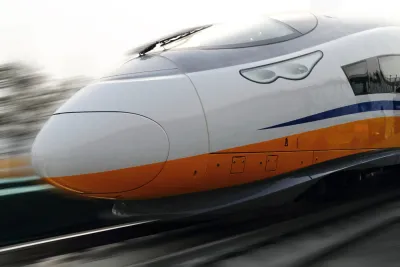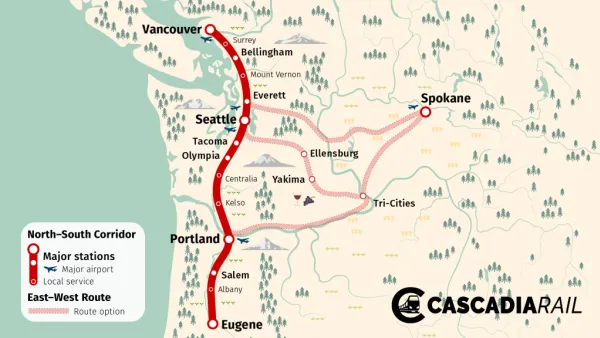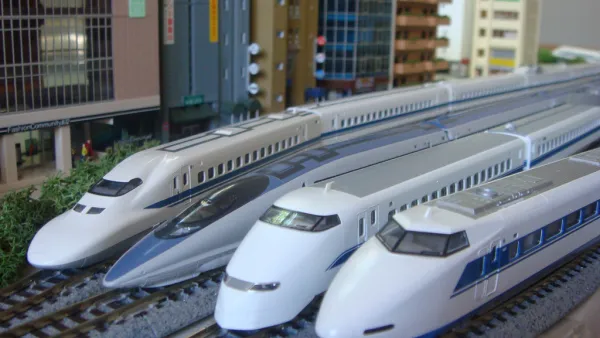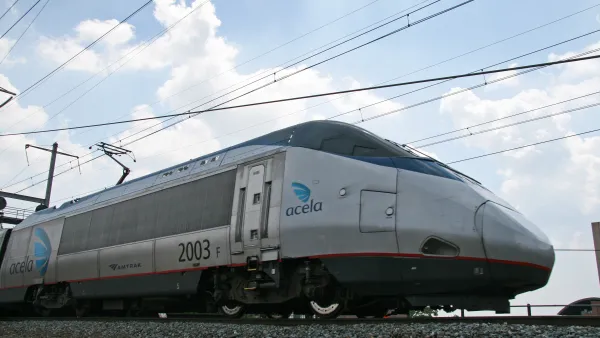High-speed rail advocates in the Pacific Northwest are pushing for a high-speed link between Vancouver, Seattle, and Portland to be part of future economic stimulus spending in the United States.

Martin Brosnan writes to anticipate and plan for economic recovery, returning to an idea that figured in the economic recovery plan for the previous recession, yet without much to show for it: high-speed rail.
After dispensing with the idea of repeating the mistakes of the country's history of car-centric economic stimulus spending, Brosnan suggests high-speed rail as a desirable approach to an infrastructure related economic stimulus:
High-speed rail, however, may be the way to go. A high-speed rail line from Portland, Oregon to Vancouver, British Columbia is the perfect project to provide hundreds of short- and long-term employment opportunities, stimulate the economy of one of North America’s top 10 most populated mega-regions, foster increased cooperation between the two nations post border-closure, and to help move people through the region and to new employment opportunities in an economy that may result in fewer people being able to afford personal vehicles. Looking back at the conception of the highway system, it seems to be the right time to invest in such a project–to accommodate large, and growing urban populations, create jobs and economic growth, and cut transportation costs.
As noted by Brosnan, some of the planning and political ground has already been cleared for a high-speed rail connection in Cascadia. There's also gathering political support federal high-speed rail spending from House Rep. Seth Moulton (D-Mass.), who has proposed a bill (complete with supplementary white paper) that would spend $250 million on high-speed rail as a form of economic relief in the wake of the pandemic. The Green New Deal would also support a shift in federal transportation policy toward rail, away from air and car travel.
FULL STORY: Should The Government Invest in High-Speed Rail to Boost a Post-Pandemic Economic Recovery?

Analysis: Cybertruck Fatality Rate Far Exceeds That of Ford Pinto
The Tesla Cybertruck was recalled seven times last year.

National Parks Layoffs Will Cause Communities to Lose Billions
Thousands of essential park workers were laid off this week, just before the busy spring break season.

Retro-silient?: America’s First “Eco-burb,” The Woodlands Turns 50
A master-planned community north of Houston offers lessons on green infrastructure and resilient design, but falls short of its founder’s lofty affordability and walkability goals.

Test News Post 1
This is a summary

Analysis: Cybertruck Fatality Rate Far Exceeds That of Ford Pinto
The Tesla Cybertruck was recalled seven times last year.

Test News Headline 46
Test for the image on the front page.
Urban Design for Planners 1: Software Tools
This six-course series explores essential urban design concepts using open source software and equips planners with the tools they need to participate fully in the urban design process.
Planning for Universal Design
Learn the tools for implementing Universal Design in planning regulations.
EMC Planning Group, Inc.
Planetizen
Planetizen
Mpact (formerly Rail~Volution)
Great Falls Development Authority, Inc.
HUDs Office of Policy Development and Research
NYU Wagner Graduate School of Public Service




























